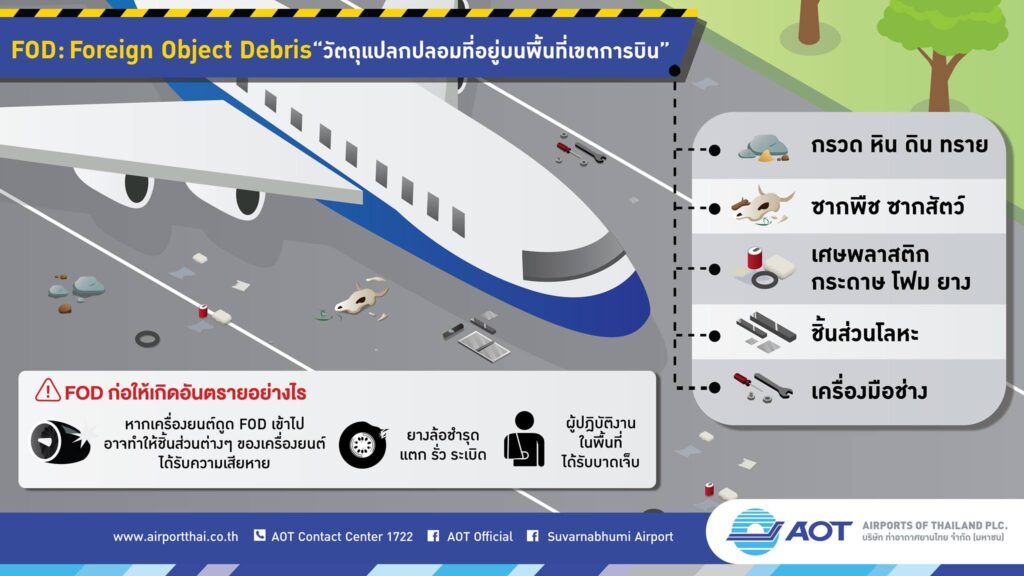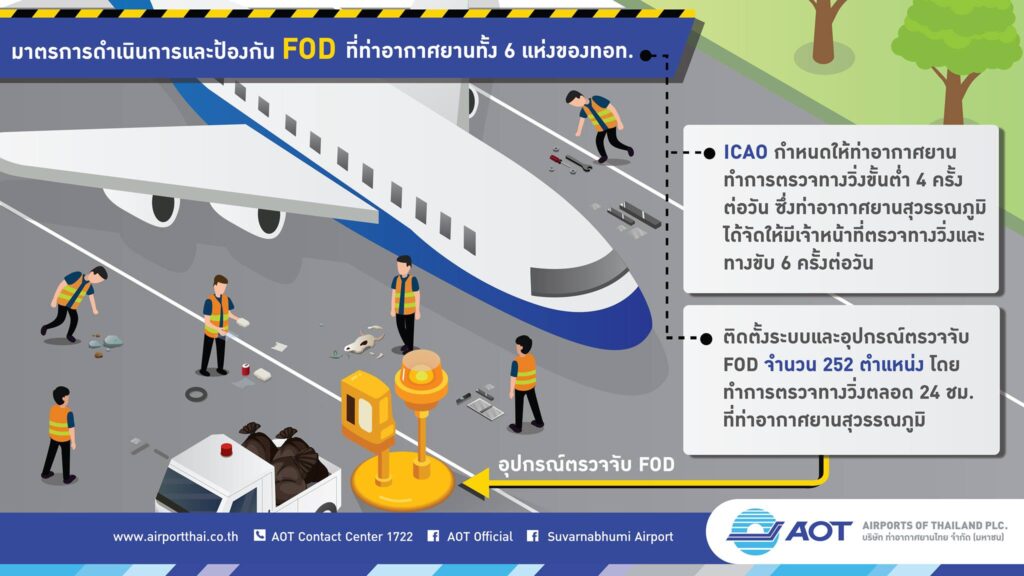Airport Safety and Security
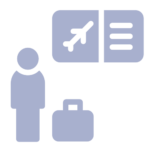
Customers
Business Partners

Regulators

บุคลากรของ ทอท.

ชุมชนและสังคม
สื่อมวลชนและสื่อออนไลน์อื่นๆ

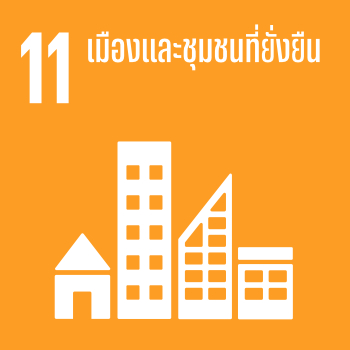
Airport Safety
Airport safety and security is an important issue that AOT must be carried out in accordance with national and international standards to protect the lives and property of service users, personnel, and business partners operating within the airport, as well as the surrounding communities and societies from persons or groups of persons who behave unlawfully or are at risk of harm. Additionally, airport safety and security is considered human rights protection regarding the right to life and safety. It also fulfills the expectations of regulatory agencies.
Policy and Management Approaches
AOT established an Aerodrome Safety Policy in accordance with laws, requirements, and recommendations of the International Civil Aviation Organization (ICAO) to be the safety management framework for all 6 airports under its responsibility. The Aerodrome Safety Management Committee; a committee of corporate-level chaired by the President, and the Aerodrome Safety Committee; a committee of airport level, supervise AOT's safety operations in alignment with AOT’s Aerodrome Safety Policy. In addition, AOT has also prepared the Aerodrome Manual (ADM), the Airport Security Programme (ASP), the Airport Contingency Programme (ACP) and the Airport Safety Management System (SMS) in accordance with national and international requirements with the Airport and Aviation Standards Group responsible for supervising and controlling the operations to strictly comply with safety and security standards.
Aerodrome Safety Policy
Enhance aerodrome safety management and operational standards along with the growing aviation industry in compliance with ICAO standards.

Support personnel and allocate budget to implement the Airport Safety Management System (SMS).

Management from all levels are responsible for airport safety to comply with regulations, indicators, and targets.

All AOT personnel must be aware and rigidly collaborate with airport safety practices.

Organize training, revise, and communicate to ensure that AOT personnel are equipped with knowledge and expertise to comply with AOT Aerodrome Safety Policy.

Campaign, promote, and persuade relevant parties to observe regulations and safety standards be conscious, and cherish safety culture.

Track and evaluate policy implementation and the Airport Safety Management System (SMS).

Encourage independent Safety Report preparation.

Actively investigate root cause of safety-related incidents.

Promote and encourage the integration of relevant security systems.
Aerodrome Safety Management and Supervision Structure
Corporate Level
AOT’s President serves as Chairman of the Aerodrome Safety Management Committee.
Airport Level
General Manager serves as Chairman of the Aerodrome Safety Committee.
● Set up the policy, work plans and procedures on AOT Acceptable Level of Safety (ALOS)
● Provide suggestions and solutions to all problems that affect the operational safety of AOT’s 6 airports that are beyond capacity of the Aerodrome Safety Committee at airport level.
● Follow up and accelerate the problem-solving operation for all 6 airports of AOT to maintain the Public Aerodrome Operating Certificate.
● Arrange quarterly meetings for Aerodrome Safety Management Committee.
● Support and promote continuous development of the Safety Management System (SMS) of the airports.
● Aerodrome Standards and Safety Department serves as the Committee’s secretary.
● Define policy in compliance with AOT’s Safety Policy to be used as AOT’s airport safety management guidelines.
● Define duties on overseeing and monitoring operational result of safety management according to the Safety Management System (SMS) under the national aviation laws and international standards.
● The Aerodrome Standards and Occupational Health Department of the airport or the Aerodrome Standards and Occupational Health Division of the airport serves as the Committee’s secretary
Safety Measurement

Airport Wildlife Hazard Management
Wildlife Hazard Management in the airport areas, especially bird strike problem, is a safety challenge which is caused by animal behavior and environmental conditions that attract them to enter the operation areas. These incidents have to be managed appropriately to ensure aviation safety, reduce aircraft damage, avoid occurrence of accidents that lead to injuries or deaths, and trip delay.
AOT has deployed measures to prevent accidents from birds constantly, such as managing bird’s food sources, habitat sites, and bird attractants. Moreover, AOT sets appropriate methods to disperse birds from the airport areas, eliminating the habituation of birds. Various dispersal methods have been developed based on recommended practices of ICAO, Doc 9137 Airport Service Manual Part 3; Wildlife Control and Reduction, which include using of auditory deterrents such as gas cannons or gunfire, or using visual deterrents such as hawk kites. All of which are operated by AOT’s staffs who have ornithological knowledge.
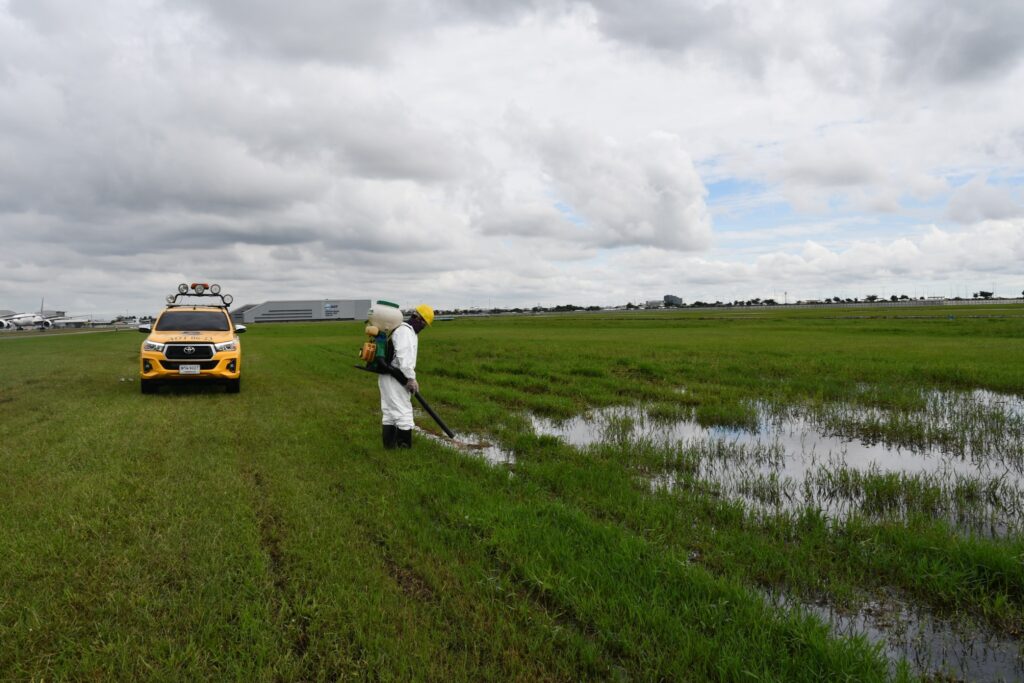
Preventive Measures Against Potential Harms from Birds and Animals that Enter the Airport Areas.
- Assess the environment and manage factors that attract birds and animals to seek foods and to live in the area such as water drainage channel, irrigation canal, lawns, ground conditions, airside fences to prevent animal trespassing, resting area and waste storage areas, etc.
- Strictly control and disperse dangerous animals throughout 24 hours and give warning of any danger from animals.
- Assess and prioritize the potential risk that may lead to harmful effects of birds and animals in the airside areas which occur as a result of land use in the 13 kilometers radius of the airport, such as fishing ponds or agricultural activities, etc.
- Review and improve preventive measures to align with current ecological systems.
- Determine the implementation procedures and provide a report in case bird strike accident occurs.
The Aviation Accident Prevention from Birds and Animals at Suvarnabhumi Airport
Realizing the importance of problems of Suvarnabhumi Airport, AOT therefore has been continuously monitoring the issue and developing the solution by launching the Bird/Wildlife Strike Control Program, which currently divides the operating measure into 3 phases, as follows:
- Short-term measures include airside patrol and dispersal of animals, monitoring area through CCTV system, disturbing/controlling the resting sites and habitat areas of birds and animals.
- Medium-term measures include the use of biochemicals to eliminate birds’ food sources, and control and prevent birds and animals’ breeding grounds.
- Long-term measures include controlling grass height and mowing at night around the runway, inspecting and cutting down large trees, adjusting the flooded areas in the airside, controlling water level, and covering water source. and animals.
AOT will collect operational data and provide annual work plan review for the highest efficiency in preventing aviation accidents caused by birds

Communicable Disease Control of the Airport
AOT has followed the international communicable disease control guideline in accordance with the Communicable Diseases Act B.E. 2558 (2015) issued by the Ministry of Health, and the International Health Regulations B.E. 2548 (2005) issued by the World Health Organization (WHO). AOT also collaborated with the airport’s Health Control, Bamrasnaradura Infectious Disease Institute, and Bureau of Epidemiology, Department of Disease Control, Ministry of Health, in order to control the communicable disease in case of discovering suspected persons of infections at the airport, such as Coronavirus (CoV), Ebola virus, or H7N9 Avian Influenza, etc.
During the COVID-19 pandemic, AOT has prepared the responsive plan to ensure safety and efficiency of its operations. The plans are classified into in phases which are pre-incident, occurring-incident, and post-incident. Each phase has clear measures and person in charge, such as social distancing, cleaning building and airport’s areas including deep cleansing at common-use touching points, providing alcohol gel and hand soap services around the terminals, preparing body temperature check for workers, visitors, and passengers by auto thermoscan where the temperature must not exceed 37.5 Degrees Celsius. In addition, AOT has also collaborated with the government sectors by providing certain areas of the terminal building to the Center for COVID-19 Situation Administration (CCSA) for screening process of the arriving passengers as well as arranging personnel to station at the CCSA at the Government House to coordinate and promptly respond to the situation according to the government measurement.
Preventive Measures for Foreign Object Debris (FOD) on Runways

Foreign Object Debris (FOD), such as plants or animal remains, and metal fragments in the airside may cause danger to aircraft operation. Therefore, AOT’s airports have established measures to prevent and detect FOD on runways, as follows:
- Inspect Runways and taxiways 6 times a day
- Install systems and FOD detection equipment which can continuously monitor runways 24 hours a day.
- Check the readiness of the systems on a regular basis.
In the event that FOD is detected, the system will display a warning signal and locate the FOD in the airside in order to allow airport officers to verify the physical data of such materials and assess the urgency in removing them from the runway which depends on the degree of danger towards the aircraft. Then, analyzing the cause of FOD found in the airside is required in order to identify future preventive measures. The data and sequence are also recorded as lesson learned database for other airports under AOT’s responsibility.
Airport Security Measures
Airport Security Programme (ASP)
All of AOT 6 airports have prepared their airport security programme (ASP) in compliance with the National Civil Aviation Security Programme (NCASP), issued by the Civil Aviation Authority of Thailand, and the standards of the International Civil Aviation Organization (ICAO) as guidelines and framework for security operation at each airport. Security measures stipulated in the Airport Security Programme of each airport are preventive and proactive plans, which would be reviewed and adjusted continuously to stay up to date.
Proactive Security Measures
AOT defines proactive security measures in collaboration with domestic and international security agencies such as Counter-Terrorist Operations Center (CTOC), Cyber and Infrastructure Security Centre in Australia, and US Transportation Security Administration (TSA), in order to stay alert on threat information and assess potential risks, as well as informing airports under AOT management to actively prepare and respond to the information in a timely and efficient manner.
Airport Contingency Plan (ACP)
All of AOT 6 airports have prepared their Airport Contingency Plans (ACP) to determine relevant units, scope of responsibilities and procedures, as well as coordination methods among airport operators, air navigators, air traffic controllers, local law enforcers, the Civil Aviation Authority of Thailand and other relevant parties that are responsible to respond to acts of unlawful interference to civil aviation. This is to adhere to requirements in the National Civil Aviation Security Programme (NCASP), relevant standards, rules and regulations in order to ensure an effective response to unlawful interference actions.
Safety Management System (SMS)
AOT follows government laws and regulations under the supervision of the Civil Aviation Authority of Thailand (CAAT) by preparing the Airport Safety Management System (SMS) in alignment with government regulations and national civil aviation safety plan, as well as being another mechanism to drive safety measurements consisting of 4 components which are safety policy and objective, safety risk management, safety assurance, and safety promotion. Additionally, AOT as an airport operator does not only manage safety within AOT but also ensures that airport services are based on safety awareness of airport stakeholders, namely airlines, ground service providers, aviation support units, and government agencies just to name a few.
Aviation Security Quality Control Programme
AOT has prepared the Aviation Security Quality Control Programme to be used as a standard for security quality control at the airports under the responsibility of AOT. The programme involves quality control activities consisting of Security Audit, Security Inspection, Security Test, and Security Survey based on inspection principles and guidelines of the National Civil Aviation Security Quality Control Programme (NCASQCP). In addition, AOT's Internal Auditors were trained in courses according to international standards.
AOT Security Risk Assessment Manual &
Practice Guideline on Level of Threat Against Civil Aviation
AOT has prepared AOT Security Risk Assessment Manual and practice guideline according to level of threat against civil aviation with the objective to be used as a guideline to identify threats and assess the airport security risks at the airport level. It is also a guideline to set measures to reduce risks and their impacts according to the level of threats of each airport as recommended by the Civil Aviation Authority of Thailand. AOT has reviewed, revised and updated manual constantly in response to the current situations and civil aviation threats.
Emergency and Contingency Plans’ Exercises
AOT conducted exercise sessions to ensure its preparedness and management system efficiency in case the emergency incident occurs. The sessions included emergency plan and contingency plan exercises among relevant internal units. The full scale and partial exercises were taken through simulated scenarios encompassed aviation safety and aviation security in accordance with ICAO’s operational guidelines and the regulations of the Civil Aviation Board No. 82 on Airport Safety Management System and the National Civil Aviation Security Programme. The emergency and contingency plans’ exercises are annually carried out at every airport of AOT with different simulated scenarios, based on specific context of each airport. The exercises are conducted to strengthen emergency preparedness as well as improving emergency response and coordination systems’ efficiency in order to minimize damage that may occur.
Management Evaluation
AOT and the Government apply the safety standard audit, in both physical and operational aspects, as the mechanism to supervise aerodrome safety standard in compliance with state’s regulations and international standards to assure of airport users’ safety. The auditing process is divided into 3 levels as follows:
-
- At Airport Level (Self Audit)
-
- The Aerodrome Standards and Occupational Health Division of each airport is responsible for auditing safety standards at the airport level.
- At Corporate Level (Internal Audit)
-
- AOT Aerodrome Standards and Safety Department is responsible for internal auditing on safety standards of every airport at least once a year, supervising safety of all airports in general, monitoring risk statistics report, defining level of risk, and searching for reducing/controlling methods to be as Low as Reasonably Practicable (ALARP) level. These implementations will be proceeded through AOT’s Aerodrome Safety Management Committee to ensure that safety deficiencies shall be rectified and safety performance shall be measured according to safety indicators and safety targets as defined by AOT.
- At State Level (State Audit)
-
- The Civil Aviation Authority of Thailand (CAAT), Ministry of Transport, is responsible for auditing and supervising safety standards of airports under AOT’s supervision on an annual basis, as well as providing opinions and suggestions to AOT on safety matters. However, CAAT is also audited and monitored by the International Civil Aviation Organization (ICAO) under the Universal Safety Oversight Audit Program (USOAP).
Other safety assurance includes wildlife hazards management by surveying and assessing danger from birds and hazardous animals within the airside, as well as surveying ecological systems within the airports and surrounding areas. Sustainable safety could not be achieved solely by regulation enforcement, but it requires sincere and continual collaboration between AOT and stakeholders. All of which are instilled in the organization’s 5 core values; Service Minded, Safety & Security, Teamwork, Innovation and Integrity, in order to demonstrate our intentions to achieve all targets and visions.
Information Systems Development on
Airport Security (e-Security) and Airport Safety (e-Safety)
AOT has developed an airport security information system (e-Security) to collect personal history, preventive security operations, issuance of personal security pass, collection of security statistics, quality control of security audits and security training courses that educate strict and secure operation procedures, which lead to enhancement of work efficiency of AOT employees and highest security for service users, workers, and other related individuals at the airport.
The system has been further developed and solved the work process problem of the existing system to become up to date. Users can save data via Web Application or Native Mobile Application. Moreover, the system will update the personal data and offenders’ records, as well as the background of persons and vehicles entering the airport areas. E-Security system will serve both centralized usage (access information of all airports) and decentralized usage (access information in the separation of each airport), and have an authentication system where an individual user has his/her own user name and password to access the system according to his/her rights. These would be able to monitor the operation procedures of those involved in the system and external incidents that may occur. It makes AOT's airports safer and builds more confidence in passengers or airlines. The system is available for use at the beginning of 2022.
In addition, AOT is currently in the process of adopting advanced and efficient information and communication technologies such as biometric identification system via fingerprint and Access Control System (ACS), etc. for screening and inspecting individuals in order to enhance safety and security of passengers and operators at the airport. This plan is scheduled to be completed at all airports, including AOT’s Head office within the year 2023.
Cultural Promotion on Safety and Security
AOT cooperates with external agencies about safety operations, such as airport safety committees at the corporate level and at the airport level. The committee comprises representatives from various units, both inside and outside the airport, and holds a meeting according to the specified rotation to jointly share information, identify, assess and reduce hazardous risks. Moreover, it also promotes mutual safety by relaying and communicating information in order to create safety culture, such as compulsory and voluntary reporting, safety training, setting up the Aviation Security Training Program (ASTP), and organizing Safety Promotion activities together with cooperation and instilling the Core Value on safety in employees, such as strictly follow safety regulations, checking the availability of tools and equipment before using, observing, warning and reporting of solutions when it will probably be unsafe, etc.


Aviation Security Training Program (ASTP)
AOT has prepared AOT Aviation Security Training Program according to the requirements of the National Civil Aviation Security Program and the National Civil Aviation Security Training Program. The objective is to provide personnel working at AOT's airports with theoretical/practical training, On-the-Job Training and achievement test under the same standards by aviation security instructors certified by the Civil Aviation Authority of Thailand. The courses contained in the training program, include Initial Training, Recurrent Training, Supervisor Course, Security Manager Course, Security Instructor Course, Internal Security Inspector Course and Security Awareness Course for those working at airports. During the COVID-19 pandemic, AOT has prepared various E-learning courses in the training plan, such as the security awareness course.
Last Updated: 11 april, 2023

